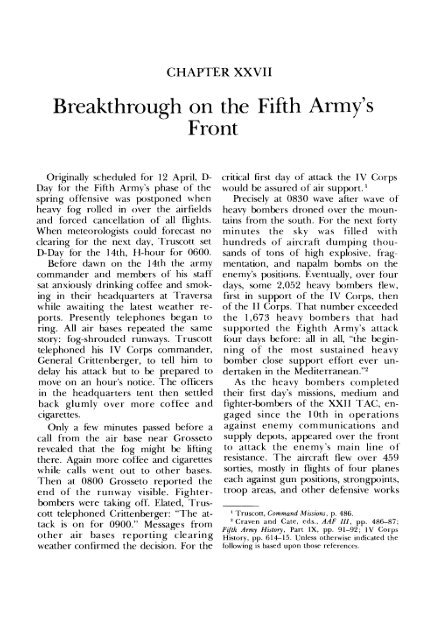Cassino to the Alps - US Army Center Of Military History
Cassino to the Alps - US Army Center Of Military History
Cassino to the Alps - US Army Center Of Military History
You also want an ePaper? Increase the reach of your titles
YUMPU automatically turns print PDFs into web optimized ePapers that Google loves.
CHAPTER XXVII<br />
Breakthrough on <strong>the</strong> Fifth <strong>Army</strong>'s<br />
Front<br />
Originally scheduled for 12 April, D<br />
Day for <strong>the</strong> Fifth <strong>Army</strong>'s phase of <strong>the</strong><br />
spring offensive was postponed when<br />
heavy fog rolled in over <strong>the</strong> airfields<br />
and forced cancellation of all flights.<br />
When meteorologists could forecast no<br />
clearing for <strong>the</strong> next day, Truscott set<br />
D-Day for <strong>the</strong> 14th, H-hour for 0600.<br />
Before dawn on <strong>the</strong> 14th <strong>the</strong> army<br />
commander and members of his staff<br />
sat anxiously drinking coffee and smoking<br />
in <strong>the</strong>ir headquarters at Traversa<br />
while awaiting <strong>the</strong> latest wea<strong>the</strong>r reports.<br />
Presently telephones began <strong>to</strong><br />
ring. All air bases repeated <strong>the</strong> same<br />
s<strong>to</strong>ry: fog-shrouded runways. Truscott<br />
telephoned his IV Corps commander,<br />
General Crittenberger, <strong>to</strong> tell him <strong>to</strong><br />
delay his attack but <strong>to</strong> be prepared <strong>to</strong><br />
move on an hour's notice. The officers<br />
in <strong>the</strong> headquarters tent <strong>the</strong>n settled<br />
back glumly over more coffee and<br />
cigarettes.<br />
Only a few minutes passed before a<br />
call from <strong>the</strong> air base near Grosse<strong>to</strong><br />
revealed that <strong>the</strong> fog might be lifting<br />
<strong>the</strong>re. Again more coffee and cigarettes<br />
while calls went out <strong>to</strong> o<strong>the</strong>r bases.<br />
Then at 0800 Grosse<strong>to</strong> reported <strong>the</strong><br />
end of <strong>the</strong> runway visible. Fighterbombers<br />
were taking off. Elated, Truscott<br />
telephoned Crittenberger: "The attack<br />
is on for 0900." Messages from<br />
o<strong>the</strong>r air bases reporting clearing<br />
wea<strong>the</strong>r confirmed <strong>the</strong> decision. For <strong>the</strong><br />
critical first day of attack <strong>the</strong> IV Corps<br />
would be assured of air support. 1<br />
Precisely at 0830 wave after wave of<br />
heavy bombers droned over <strong>the</strong> mountains<br />
from <strong>the</strong> south. For <strong>the</strong> next forty<br />
minutes <strong>the</strong> sky was filled with<br />
hundreds of aircraft dumping thousands<br />
of <strong>to</strong>ns of high explosive, fragmentation,<br />
and napalm bombs on <strong>the</strong><br />
enemy's positions. Eventually, over four<br />
days, some 2,052 heavy lx>mbers flew,<br />
first in support of <strong>the</strong> IV Corps, <strong>the</strong>n<br />
of <strong>the</strong> II Corps. That number exceeded<br />
<strong>the</strong> 1,673 heavy bombers that had<br />
supported <strong>the</strong> Eighth <strong>Army</strong>'s attack<br />
four days before: all in all, "<strong>the</strong> beginning<br />
of <strong>the</strong> most sustained heavy<br />
bomber close support effort ever undertaken<br />
in <strong>the</strong> Mediterranean."2<br />
As <strong>the</strong> heavy bombers completed<br />
<strong>the</strong>ir first day's missions, medium and<br />
fighter-bombers of <strong>the</strong> XXII T AC, engaged<br />
since <strong>the</strong> 10th in operations<br />
against enemy communications and<br />
supply depots, appeared over <strong>the</strong> front<br />
<strong>to</strong> attack <strong>the</strong> enemy's main line of<br />
resistance. The aircraft flew over 459<br />
sorties, mostly in flights of four planes<br />
each against gun positions, strongpoints,<br />
troop areas, and o<strong>the</strong>r defensive works<br />
[ Truscott, Command Missions, p. 486.<br />
2 Craven and Cate, eds., AAF III, pp. 486-87;<br />
Fifth <strong>Army</strong> His<strong>to</strong>ry, Part IX, pp. 91-92; IV Corps<br />
His<strong>to</strong>ry, pp. 614-15. Unless o<strong>the</strong>rwise indicated <strong>the</strong><br />
following is based upon those references.
















